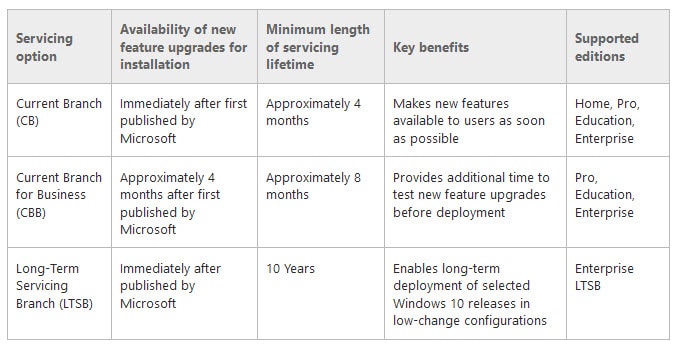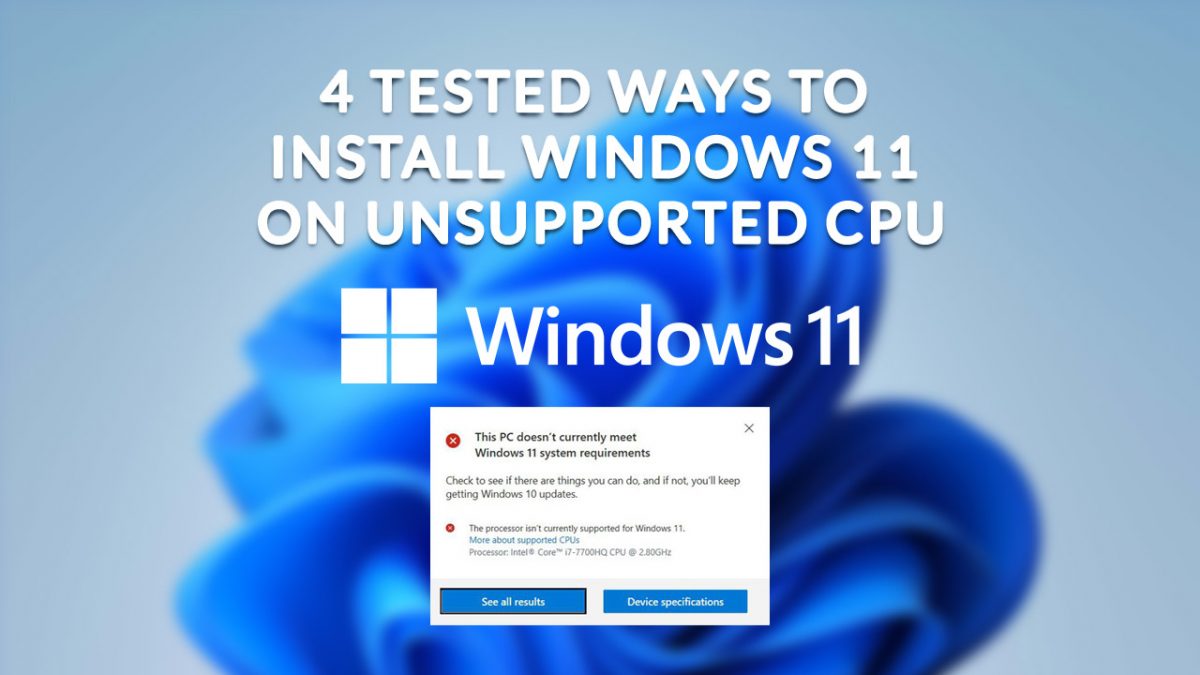Microsoft finally reveals missing information about updates in Windows 10

Updates released for Microsoft's Windows 10 operating system are different in several regards. While most home users still get them through Windows Update, several key aspects of updates have changed in Windows 10.
You may have read about feature updates, Windows 10 servicing, deferred updates or the different servicing branches that Microsoft created for Windows 10 but since Microsoft did not reveal too much about them, it was not really clear how they'd affect administrative tasks in Windows environments.
The new Introduction to Windows 10 servicing document on Technet reveals missing information about updates. Designed specifically for Enterprises, it is providing home users and businesses with vital information about Windows 10 servicing and updates.
The article that Microsoft published is highly technical and a long read. The following paragraphs provide you with a summary of core information revealed in the article.
Microsoft distinguishes between two types of updates in Windows 10:
- Servicing updates which are important updates such as security or stability fixes.
- Feature upgrades that deliver new features to devices running Windows 10.
Feature upgrades, note that Microsoft calls them upgrades and not updates, always contain an entire copy of Windows so that they can be used to install Windows on existing devices. It is like Windows 10.1, 10.2 and so without these releases being named that way.
Microsoft plans to release between two and three feature upgrades per year and to publish accompanying servicing updates for supported feature upgrades.
Servicing updates will continue to be delivered on Patch Tuesday primarily (second Tuesday of a month) but may also be pushed out at other times when the need arises. This is exactly the same as it is done today for all supported Microsoft operating systems.
One difference here, as you may have noticed already, is that these patches will only be delivered to systems running supported feature upgrades.
This in turn means that Home users who run Windows 10 on machines won't be able to block feature upgrades for a long period of time as they won't receive servicing updates anymore.
Microsoft distinguishes between two branches relevant for Home and Business environments. The Current Branch receives feature upgrades immediately and the servicing lifetime of each feature upgrade is a minimum of four months.
This seems to confirm that these feature upgrades need to be installed in that time period for the system to continue receiving security updates.
The Current Branch for Business delays the availability of feature upgrades for four months and extends the minimum length of the servicing lifetime to eight months.
Another interesting difference between updates for Windows 10 and previous Windows operating systems is the cumulative nature of Windows 10 releases.
It is important to note that, in order to improve release quality and simplify deployments, all new releases that Microsoft publishes for Windows 10 will be cumulative. This means new feature upgrades and servicing updates will contain the payloads of all previous releases (in an optimized form to reduce storage and networking requirements), and installing the release on a device will bring it completely up to date.
Microsoft notes that it is no longer possible to "install a subset of the contents of a Windows 10 servicing update".
The remainder of the article reveals how Microsoft releases Windows 10 feature upgrades.
When a new feature upgrade gets released, it is made available to Current Branch systems right away. What then follows is several months of servicing updates followed by the release of the feature upgrade plus all servicing upgrades to Current Branch for Business systems.
The actual frequency and timing of releases will vary according to Microsoft.
Although Microsoft is currently planning to release approximately two to three feature upgrades per year, the actual frequency and timing of releases will vary. Because the servicing lifetimes of feature upgrades typically end when the servicing lifetimes of other, subsequent feature upgrades begin, the lengths of servicing lifetimes will also vary.
Now You: What do you make of this? Good move or bad?


















Martin,
I just installed some update for my windows 7 and am finding an icon on my toolbar for windows 10 info that I can’t get rid of. I know awhile back you listed the update number(s) that had this garbage init and I can’t fin it can you list those up date again or email them to me.
Thanks
Jim
I think this is what you mean: https://www.ghacks.net/2015/06/01/how-to-block-the-windows-10-update-notification-in-earlier-versions-of-windows/
I had to buy a new ultrabook that met all my requirements at a good price. Unfortunately it came preloaded with Windows 10 Home, but after playing with it for 3 weeks, I actually like it, since you can prevent all drivers from being downloaded and installed. This is a good thing, as a generic keyboard driver killed a keyboard function I like to use. Privacy concerns are minimized by implementing the options described in this video.
https://youtu.be/TU9ECwhi3hc
:D Looks like only my XP system is safe. When it becomes necessary, and it looks like it will, I will take the Win7 computer offline and find myself a gadget with something besides Windows on it to do my shopping, banking and research. The way Windows is moving is ruining the internet for me. Oh well, maybe I will get more work done.
Am I reading that right, you only get service from Microsoft for 4 months after install?
If you didn’t install a feature upgrade then yes, if you blocked the installing of a feature upgrade for longer than 4 months you would no longer receive security patches (updates) after those 4 months.
Even though I’m sick as hell and most of you guys are probably just as hard core as me, but if you read it again slowly, you can see Microsoft is clearly setting their selfs up for a paid prescription plan. Say what you want noting comes free in this world and Google, Microsoft, Apple and the NSA are all behind this, there’s BIG money to be made in all of this Spyware and to be honest I shouldn’t have to spend hours disabling and removing features on the count of Spyware, Welcome To The Brave New World, were nothings yours.
I solve all these convoluted windows updates and privacy invasion by simply just using Android from now on. My apps are all Android anyway. Let windoze rot and microshaft my finally wake up or go under. Don’t care either way.
You are delusional if you think android is any better off than anything microsoft.
Not sure it can be called good or bad, Microsoft have made it clear what they want Windows to become so in that way I guess this model of upgrades/updates is good, on the other hand what used to be a 5-10 year servicing lifetime for previous version of Windows now seems to be reduced down to 4-8 month for the majority of users.
I guess the choice of upgrading to a new version of Windows is something people are going to have to do every four months now, no OS is worth that investment of time (imho), having to spend time reading and learning about new features, making a decision on whether to continue using it or not every four month is not something I’m willing to do.
There is nothing in Win10 that I really need. There is plenty in Win10 that annoys me. Personally I will be sticking with Win7 and continuing the lookout for an alternative to MS.
Good or bad? Different people may see this differently, but to me all this is bad. Very bad. It looks like Microsoft keeps gradually moving towards the goal of taking full, exclusive control of the user’s OS.
— To give you a metaphor, I guess Microsoft’s idea of a car would be a vehicle with a firmly locked hood, leaving the engine bay inaccessible to the owner. Actually, this car owner might still own the car but not the locked-away engine: this engine would be on loan from Microsoft. And of course, such a Microsoft car would phone home (or drive itself automatically to the workshop) for opaque, undefined, mysterious, supposedly beneficial maintenance jobs: and the car would do this regardless if the car “owner” likes this or not.
— I bought my Win7 and Win8 operating systems, just like I bought my PC hardware. And as the owner I feel entitled to keeping control. In the same way as I can decide to tune my own car engine just the way I like it, I feel entitled to tune my own computer OS exactly the way I like it. This includes deciding for myself what Microsoft security and feature updates I need to install, and what Microsoft updates I rather want to skip.
— Microsoft’s take-it-all-or-leave-it update policies illustrate once again why I passed on upgrading my computers to the generously offered “free” Windows 10 (of course, I also do not want to pay for “freebies” by handing over personal data and giving up some privacy). I fear that in the near future Microsoft may even decide to retro-force this very same kind of upgrade policy onto Windows 7 and 8 users as well. Maybe many users won’t care, but I’m with those who will. On one of my laptops, I am already trying to get a little more used to Linux.
This is exactly the way I perceive Windows 10, and the metaphor is excellent because it illustrates perfectly IMO the manufacturer’s policy.
I’m presently in the expectancy of what my OS will be after Windows 7 because at this time Windows 10 is not, definitely not the next step.
Microsoft’s policy is rude like dictatorship is. In fact all major companies, Web included, are relevant of what power can lead to : the world conceived as their oyster. I’m sorry to bring to the front an old word but this is what has long been referenced as plain imperialism, factual even out of a doctrinal scope, like a mother-in-law can be to carry on with another metaphor.
I agree with everything you said. At this point I consider Win10 to be spyware. I have one computer running Win7pro. It has financial and personal things that I don’t want to share with Microsoft (or anyone else). I updated Win7 to the point that everything works well then took the computer off-line. I don’t plan on reconnecting it to the internet for any reason. If Google, Microsoft, Apple or the NSA want to watch me visiting ghacks and writing emails like this, fine. But, that’s all their getting. I like the idea of my computers being mine!
It’s an interesting article but after a test of about 20 days I come back to Windows 7 and now I feel to home.
Windows 7, in my opinion is the last serious Microsoft S.O.